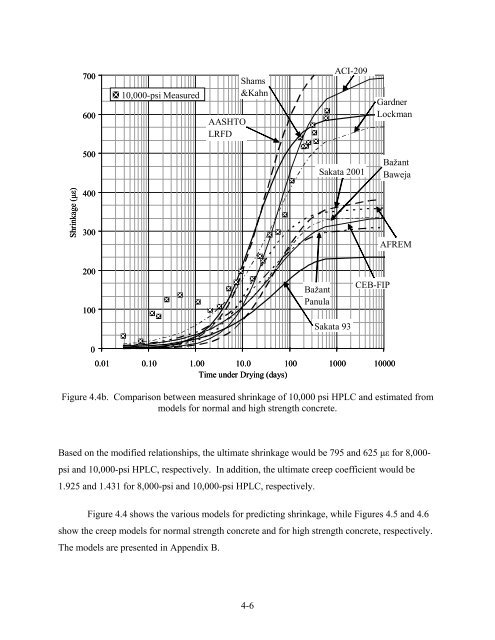Lightweight Concrete for High Strength - Expanded Shale & Clay
Lightweight Concrete for High Strength - Expanded Shale & Clay
Lightweight Concrete for High Strength - Expanded Shale & Clay
You also want an ePaper? Increase the reach of your titles
YUMPU automatically turns print PDFs into web optimized ePapers that Google loves.
700<br />
600<br />
10,000-psi Measured<br />
Shams<br />
&Kahn<br />
AASHTO<br />
LRFD<br />
ACI-209<br />
Gardner<br />
Lockman<br />
500<br />
Sakata 2001<br />
Bažant<br />
Baweja<br />
Shrinkage (µε)<br />
400<br />
300<br />
AFREM<br />
200<br />
100<br />
Bažant<br />
Panula<br />
Sakata 93<br />
CEB-FIP<br />
0<br />
0.01 0.10 1.00 10.0 100 1000 10000<br />
Time under Drying (days)<br />
Figure 4.4b. Comparison between measured shrinkage of 10,000 psi HPLC and estimated from<br />
models <strong>for</strong> normal and high strength concrete.<br />
Based on the modified relationships, the ultimate shrinkage would be 795 and 625 µε <strong>for</strong> 8,000-<br />
psi and 10,000-psi HPLC, respectively. In addition, the ultimate creep coefficient would be<br />
1.925 and 1.431 <strong>for</strong> 8,000-psi and 10,000-psi HPLC, respectively.<br />
Figure 4.4 shows the various models <strong>for</strong> predicting shrinkage, while Figures 4.5 and 4.6<br />
show the creep models <strong>for</strong> normal strength concrete and <strong>for</strong> high strength concrete, respectively.<br />
The models are presented in Appendix B.<br />
4-6















